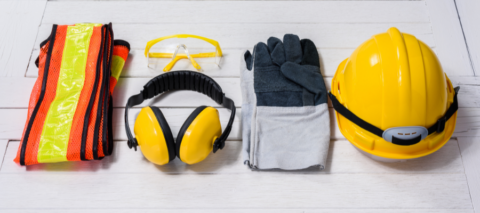We know that wearing a hard hat on the job is a no-brainer, but you might be surprised at the amount of occupational head injuries occur from the lack of wearing proper head protection. We want to make sure you’re protecting your most valuable asset, so here’s a quick refresher course on how to get the most out of your on-the-job head gear.
1.
The American National Standards Institute (ANSI) developed requirements for industrial head protection relating to impact protection, penetration protection, and electrical insulation protection. Along with the “ANSI” marking on the shell, make sure your hat has following information must be marked inside the hard hat:
• The manufacturer’s name or identifying mark
• Date of Manufacture
• The legend, “ANSI Z89.1”
• The Type and Class Designation
• The approximate head size range
2.
According to OSHA, a first critical step in developing a comprehensive safety and health program is to identify the physical and health hazards in your workplace. If you’re an employer, your employees will need to wear head protection if any of the following may occur on your worksite:
• Objects might fall from above and strike them on the head;
• They might bump their heads against fixed objects, such as exposed pipes or beams; or
• There is a possibility of accidental head contact with electrical hazards.
3.
This fact is pretty straight froward (no pun intended). To avoid accidents such as this, be sure you or your employers are wearing approved hard hats at all times.
4.
Again, this statement is self-explanatory; wear your head gear and be alert.
5.
Whether you’re wanting to stand out in the crowd or just repel heat from the sun, painting your hard hat is a bad idea. The paint’s solvents will soften your hat’s shell or cause other material damage, thus compromising the hat’s integrity and putting you in danger.
6.
Many workers may be wearing a hard hat well past its useful life without even knowing it. Although your hat may look fine, its durable exterior could be disguising its need for replacement. Some manufacturers recommend that your hard hat be replaced every 12 months, regardless of appearance. A careful review of your work site is critical to ensure that the degradation of the hard hat’s material is not being accelerated due to extreme work conditions.
7.
Even if your hard hat meets all other requirements, if it’s too large or too small, it is not suitable to wear on the worksite. There are a variety of adjustability features available when choosing hard hats for your crew, so if frequent resizing is anticipated during the job, look for adjustability features that are quick and easy to use.
8.
The use of stickers is acceptable on most of today’s hard hats, as long as you follow a few simple rules. Make sure they’re pressure sensitive and non-metallic and that they are placed at least 1/2 inch from the helmet’s edge. And again, never use stickers to cover up damage.
9.
As you well know, hard hats protect your head when you’re at risk of impact or penetration from bumping your head or from falling tools or materials on the job. Avoid being a part of this statistic– use your head and wear your hard hat.
10.
Use a mild detergent and warm water to clean your hard hat, and rinse it in clear water. Then, wipe the shell dry and allow the suspension system, sweatband, and accessories to air dry thoroughly. Make sure you perform a visual inspection each day for signs of damage. If your hard hat has any dents, cracks, abrasions, gouges, etc, it should not be worn and be replaced immediately.
At OHC we can clean up, fix, and heal injuries on the job – that’s what we’re here for. But we believe that prevention is always better than the cure. Safety is a full-time job, and if done right, it will save you money and will allow you to be a more productive company. Be diligent with occupational and workplace safety. Always wear or demand others to wear their PPE’s, and remember that wearing a hard hat (a proper hard hat, to be exact) is not on option– it’s a requirement. Let’s make a safer workplace together. And if an accident should ever occur, you know Occupational Healthcare Center (OHC), Dr. Taylor, Dr. McMillian, and our entire professional staff are here when you need us.
If you need any more information on industrial medicine, occupational health, your workplace safety or you need a work-site audit and evaluation, please contact OHC at ddaniel@occupationalhc.com or call 251.436.8039.
Learn more about Occupational Health Center (OHC) in Mobile, Alabama
FOLLOW @occupationalHC
LIKE OHCMobile
///////////////////////////////////
References:
http://www.bullard.com/V3/products/head_face/head_protection/Standards/
http://www.grainger.com/content/qt-241-hard-hat-requirements
https://www.osha.gov/Publications/osha3151.html
http://ohsonline.com/articles/2007/03/wearing-a-hard-hat-is-only-half-the-job.aspx
http://ohsonline.com/articles/2014/03/01/tips-for-selecting-and-maintaining-hard-hats.aspx
http://ohsonline.com/articles/2014/03/01/tips-for-selecting-and-maintaining-hard-hats.aspx
http://www.safetyunlimited.com/blog/safetymatters/post/2014/06/01/Weekly-Safety-Meeting-Hard-Hat-Safety.asp
http://www.ehss.vt.edu/programs/PPE_appendix.php






